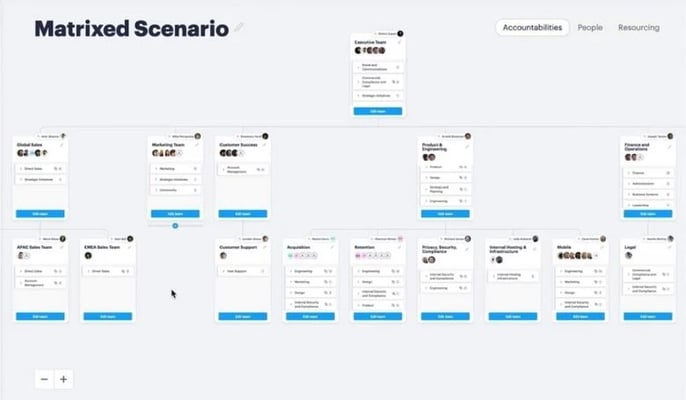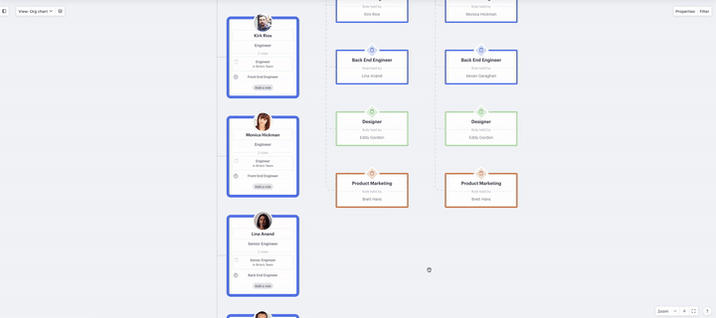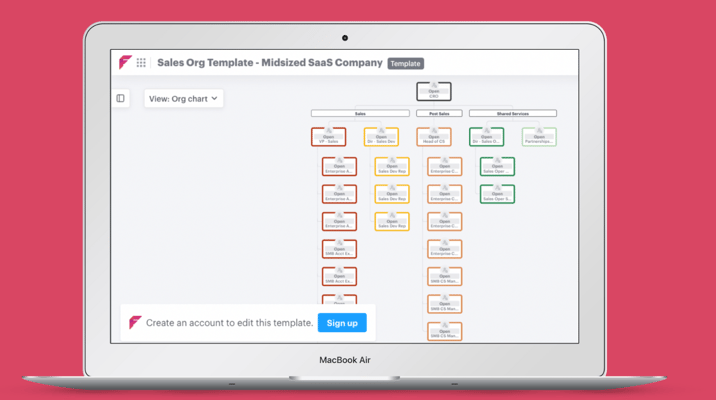The importance of understanding a company's structure and the relationships between employees cannot be overstated in today's dynamic business landscape. Personnel flowcharts, which serve as the backbone of organizational charts, play a critical role in accurately depicting these connections.
Understanding Organizational Charts: Hierarchical, Matrix, and Flat Structure Explained
Organizational charts serve as visual representations of a company's structure, outlining roles, responsibilities, and relationships between employees at various levels. Broadly, there are are number of types of organizational charts, including popular ones like hierarchical, matrix, and flat structure charts.
1. Hierarchical Chart

Hierarchical charts are the most traditional and widely-used type. They provide a clear visual of a company's hierarchy, displaying top management or executives at the top, followed by middle managers, lower-level managers, and employees. The hierarchical structure is characterized by vertical lines that represent relationships between individuals and departments. These charts work best in large organizations with several departments and levels of management.
2. Matrix Chart:

Matrix charts are best suited for organizations handling multiple products or projects, which require extensive collaboration between departments. This chart type combines vertical hierarchy and horizontal connections to show the interplay between different teams, such as engineering and marketing. Matrix charts help foster flexibility and efficient communication within organizations requiring a higher degree of interdepartmental cooperation.
3. Flat Structure Chart:

Flat structure charts are most common in smaller companies or those embracing a modern, less hierarchical culture. These charts exhibit fewer levels of management, fostering a sense of collaboration and employee autonomy. Flat structure charts work well for startups, small businesses, and organizations that prioritize a decentralized approach to decision-making.
Constructing Personnel Flowcharts: Identifying Management Levels and Designing Diagrams
Personnel flowcharts are integral to organizational charts, as they depict the hierarchy of individuals based on their roles and responsibilities within the organization. To create an effective personnel flowchart, follow these essential steps:
1. Identify Different Levels of Management: Begin by identifying different management levels within your organization. Typical categories include top-level management (CEOs, presidents, board of directors), middle managers (department heads, team leaders), and lower-level management (supervisors, foremen).
2. Place Individuals within Appropriate Levels: After identifying various management levels, ensure individuals or job roles are accurately placed within the personnel flowchart. This placement will contribute to a coherent representation of your company's hierarchy.
3. Use Lines to Represent Relationships: Represent relationships between individuals or job roles via solid and dotted lines. Solid lines signify direct relationships (e.g., direct reports or supervisory connections), while dotted lines indicate indirect relationships (e.g., secondary supervisor or advisory roles).

The Role of Middle Managers in Organization Flowcharts
Within the intricate labyrinth of organization flowcharts, a group of individuals serve as crucial conduits between top executives and lower-level management. These individuals are the middle managers, and their function is indispensable for creating cohesion and unity across departments and teams.
Middle managers are often depicted on organization flowcharts sitting comfortably in the middle of the pyramid, connecting upper management's broad strategic vision with the practical tasks executed by lower-level staff. They relay executive decisions, manage their teams, and align operational tasks with overarching company goals. They are the linchpins that hold the wheels of an organization together, ensuring a seamless flow of information throughout the organization and facilitating the translation of strategic plans into tactical operations.

But the role of middle managers extends far beyond mere information transmission. They are also responsible for fostering a positive work environment, coaching and developing team members, identifying potential risks and challenges, and contributing to continuous process improvement. Their unique position enables them to provide valuable feedback to upper management, playing a key role in shaping strategic decisions.
In the vast and often complex landscape of organization flowcharts, the inclusion of middle managers not only helps delineate the chain of command but also clarifies their roles, relationships, and responsibilities within the business ecosystem. This increased clarity can minimize misunderstandings, streamline communication, and foster increased transparency and efficiency within the organization.
Furthermore, when middle managers are accurately represented on the organization flowcharts, they become more accountable for their responsibilities. It allows for a more comprehensive performance assessment and encourages middle managers to actively participate in achieving organizational objectives. Thus, effective integration of middle managers into your organization's flowcharts can significantly enhance the performance, harmony, and overall success of your business.
Interpreting Dotted Lines in Organization Flowcharts: Indirect Relationships and Advisory Roles
Organization flowcharts offer a visual roadmap of a company's structure, presenting clear lines of authority and responsibility. A critical element in these charts that often stumps the uninitiated is the use of dotted lines. But what do these dotted lines represent? Simply put, dotted lines within organization flowcharts depict indirect relationships or advisory roles, such as employees reporting to multiple supervisors or having distinct roles across different projects.
These indirect relationships can occur in matrix structures, where employees may report to a functional manager for daily tasks but also have a project manager for specific initiatives. This arrangement enhances the flexibility of resource allocation and promotes cross-department collaboration. As a result, it is paramount that these relationships are accurately represented in the organizational chart to avoid confusion and maintain organization-wide communication and understanding.
In addition, dotted lines can also indicate advisory roles. For instance, a Human Resources consultant might have a dotted line to several different department heads, showing their role in advising these departments without having direct control or responsibility.
Inclusion of dotted lines in organization flowcharts is more than just a visual cue; it highlights the complexities of the company's structure and showcases the nuanced connections that might otherwise be overlooked. This improved visibility of interdepartmental relationships can aid in strategic planning, foster stronger collaboration, and enhance organizational resilience.
Moreover, by providing an accurate representation of employees' roles and reporting structures, dotted lines can also facilitate the creation of more balanced workloads and fairer performance evaluations. Thus, the inclusion of these dotted lines in your organizational flowcharts can contribute to a more cohesive, better-performing organization, and ultimately, a more harmonious and productive work environment.
Conclusion
Understanding levels of organization flowchart and effectively representing relationships within a company has far-reaching benefits. Accurate organizational charts streamline communication, increase clarity, and foster better decision-making within an organization. With tools like Functionly, you'll be equipped to create and utilize effective personnel flowcharts and organizational charts, enhancing your company's overall efficiency and success.




